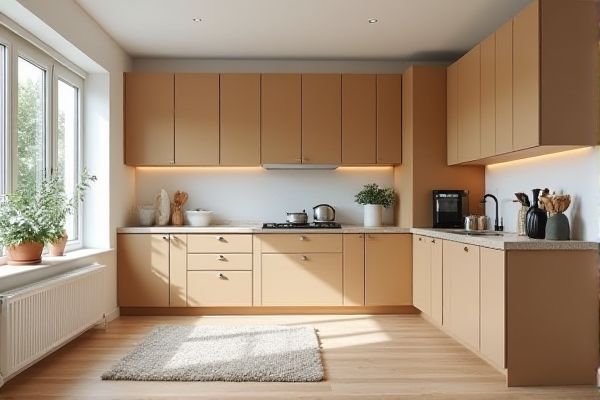
MDF cabinets offer a smooth, uniform surface ideal for painting, while plywood cabinets provide greater durability and resistance to moisture, making them suitable for high-use environments. Discover which material best fits your cabinet needs by exploring the detailed comparison in the rest of this article.
Table of Comparison
| Feature | MDF Cabinets | Plywood Cabinets |
|---|---|---|
| Material | Medium Density Fiberboard, engineered wood composite | Layered wood veneers glued for strength |
| Durability | Moderate, prone to water damage | High, resistant to warping and moisture |
| Cost | Typically lower price | More expensive but longer-lasting |
| Weight | Heavier than plywood | Lighter, easier to handle |
| Finish | Smooth surface ideal for paint | Natural wood grain, suitable for stains and veneers |
| Moisture Resistance | Low resistance, absorbs water | Good resistance, better for humid areas |
| Structural Strength | Less strong, suitable for cabinet doors and panels | Strong and stable, ideal for cabinet frames |
| Environmental Impact | Uses recycled fibers, but contains formaldehyde | Natural wood, often sustainably sourced |
Introduction to MDF and Plywood Cabinets
MDF cabinets are crafted from engineered wood fibers bonded with resin, offering a smooth, uniform surface ideal for painting and intricate designs. Plywood cabinets consist of layers of wood veneers glued together, providing superior strength and natural wood grain patterns perfect for staining. Choosing between MDF and plywood cabinets depends on your budget, desired finish, and durability needs to enhance your kitchen's aesthetic and functionality.
Material Composition: MDF vs Plywood
MDF cabinets are crafted from finely ground wood fibers bonded with resin under heat and pressure, resulting in a smooth, dense, and uniform material ideal for painted finishes. Plywood cabinets consist of multiple layers of thin wood veneers glued together with grain patterns alternating for strength, offering superior durability and resistance to warping. MDF excels in providing a stable surface for intricate designs, while plywood is preferred for structural integrity and moisture resistance.
Strength and Durability Comparison
MDF cabinets offer smooth surfaces ideal for painting but lack the natural strength and moisture resistance found in plywood, making them more prone to swelling and damage over time. Plywood cabinets provide superior strength and durability due to their layered wood veneer construction, which resists warping and stands up better to heavy use and humidity. Choosing plywood can enhance the longevity of your cabinets, especially in environments with fluctuating moisture levels.
Moisture Resistance and Stability
MDF cabinets offer excellent moisture resistance due to their engineered wood fibers and resin composition, making them less prone to warping and swelling compared to plywood. Plywood cabinets provide superior stability because of their layered construction, which resists bending and splitting more effectively under stress. When choosing between MDF and plywood for your cabinets, consider the environment's humidity levels to ensure optimal durability and performance.
Cost Differences: MDF vs Plywood
MDF cabinets generally cost less than plywood cabinets due to the lower price of engineered wood fibers compared to natural wood veneers. Plywood offers superior strength and durability, often justifying its higher price for long-term cabinetry investments. Your choice depends on budget priorities and the desired balance between cost and cabinet longevity.
Aesthetics and Surface Finishes
MDF cabinets offer a smooth, uniform surface ideal for painted finishes, resulting in a sleek and contemporary look without the grain inconsistencies found in plywood. Plywood cabinets display a natural wood grain that enhances aesthetics when stained or varnished, providing a warm, authentic appearance preferred in traditional or rustic designs. MDF's engineered composition allows for precise detailing in decorative profiles, while plywood's layered structure lends durability but may show visible edges and knots affecting finish consistency.
Ease of Installation and Workability
MDF cabinets offer smooth surfaces that are easy to cut, drill, and shape, making installation straightforward for both professionals and DIY enthusiasts. Plywood, while more durable, can pose challenges due to its layered structure, which may cause splintering or require pre-drilling to avoid splitting. Choosing MDF or plywood for your cabinets depends on your prioritization of workability, with MDF often providing greater ease during installation processes.
Environmental Impact and Sustainability
MDF cabinets are made from wood fibers bonded with resins, often including formaldehyde-based adhesives that can release volatile organic compounds (VOCs), impacting indoor air quality and sustainability. Plywood cabinets typically use layers of veneer wood, which tend to have fewer chemical additives and better structural durability, contributing to lower environmental impact over time. Your choice between MDF and plywood should consider the balance between emissions, resource use, and the potential for recycling or biodegradability to support eco-friendly cabinetry.
Common Applications in Cabinetry
MDF cabinets excel in painted finishes and intricate designs, making them ideal for modern kitchen and bathroom cabinetry with smooth surfaces. Plywood cabinets offer superior strength and moisture resistance, favored in structural applications such as base cabinets and high-traffic areas. Your choice depends on the balance between aesthetic appeal and durability requirements in cabinetry projects.
Choosing the Best Material for Your Cabinets
MDF and plywood are both popular materials for cabinets, with MDF offering a smooth surface ideal for painting and intricate designs, while plywood provides superior strength and moisture resistance, making it better suited for long-lasting, structural applications. Plywood cabinets typically consist of multiple layers of wood veneer, granting enhanced durability and resistance to warping over time, whereas MDF is engineered from fine wood fibers that can be more susceptible to water damage if not properly sealed. When choosing the best material for your cabinets, consider the balance between budget, desired finish, and the cabinet's exposure to humidity or heavy use to ensure optimal performance and longevity.
 homyna.com
homyna.com